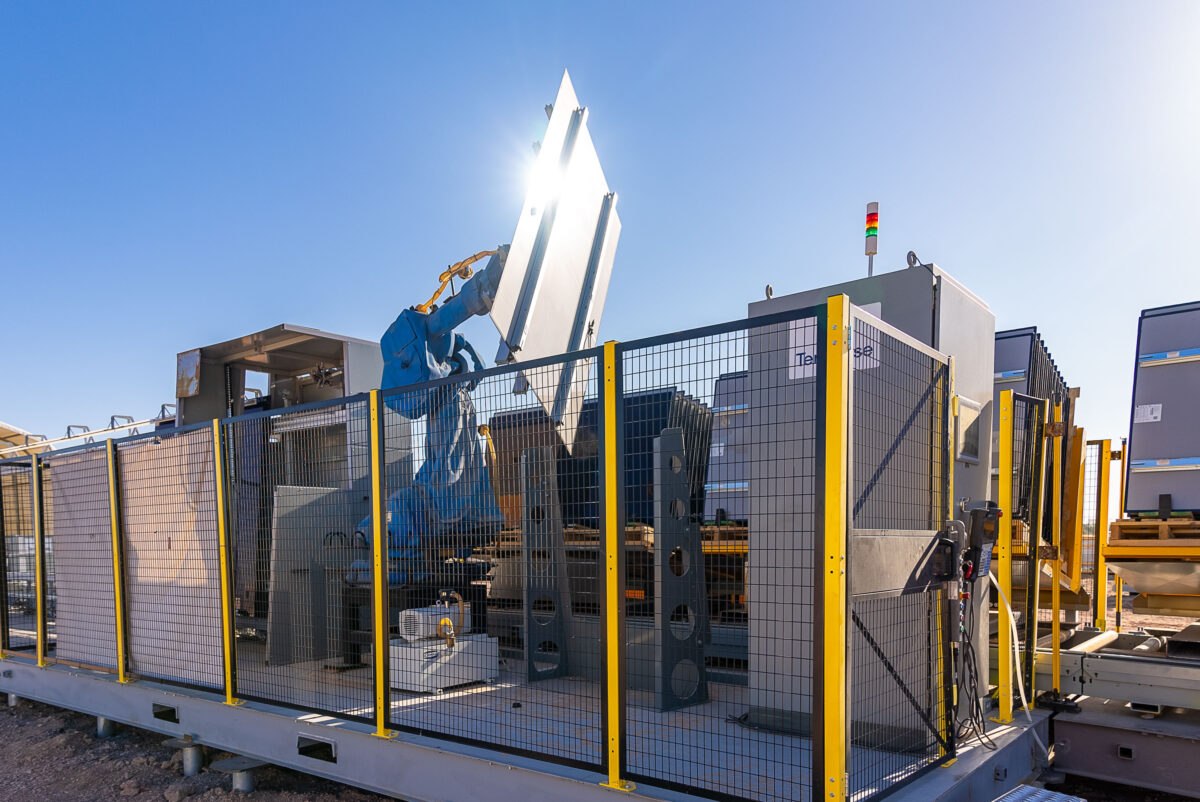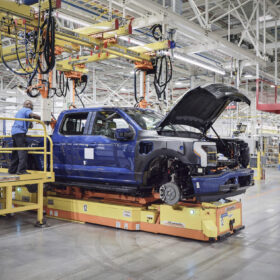The future of solar module design will be heavier, not lighter. With hail and extreme weather events increasing, module manufacturers are expected to shift toward thicker glass to improve impact resistance and long-term durability. This will significantly improve their ability to withstand high-energy hail impact and windborne debris. While this design shift enhances system survivability, it also presents a critical challenge: heavier modules require a new approach to installation.
Today’s large-format modules already weigh ~70 pounds, pushing the limits of what human installers can safely handle. OSHA guidelines and NIOSH lifting models highlight the risks: carrying heavy objects multiple times per day, above knuckle height, away from the body (especially overhead), dramatically increases the likelihood of musculoskeletal injuries. Imagine a team of workers lifting 100+ lbs. modules from crates, walking them down rows of solar arrays, and mounting them on fixed-tilt or tracker systems hundreds of times per day (especially with moderate amounts of wind), it’s not just an efficiency challenge, it’s a workplace safety crisis.
The case for robotics in solar module installation
Reducing module size is not a viable solution to the weight problem either. The large-format promise of a smaller number of modules per megawatt has reduced racking and structural costs and improved installation efficiency. These downstream savings in conjunction with the advent of the 210mm wafer have in-turn driven module designs and their volumes to the scale seen today. Reversing course and making modules smaller would increase the number of units per project, leading to more electrical and mechanical connections, which in turn raises installation labor, material costs, and long-term reliability risks. Large-format modules will persist because their downstream cost benefits outweigh the challenges of handling them. The only logical path forward is to remove human labor from the lifting equation.
This need for automation is amplified by a severe labor shortage in key solar markets, with workforce availability already limiting deployment timelines. Solar installers are in high demand but short supply, and as the industry scales insatiably, the gap between workforce availability and project needs will only widen. Instead of forcing workers into repetitive, injury-prone tasks, robotics can allow skilled labor to move into higher-value roles, such as project management, system commissioning, and electrical installation. This shift not only protects workers but also creates opportunities for career growth in an industry poised for long-term expansion.
The hidden costs of manual labor: Workman’s comp and budget offsets
Solar construction budgets don’t just account for labor wages, they also include workman’s compensation insurance, injury liability, and lost time due to work-related injuries. As module weights increase, the frequency of strain injuries, back issues, and repetitive motion disorders will inevitably rise, driving up workman’s compensation claims and increasing insurance costs. For developers and EPCs, these are costs that will be absorbed across the board and put downward pressure on project viability.
If left unaddressed, this increase in risk isn’t just a safety issue, it’s a financial issue. Over time, the added insurance burdens from increased injuries will offset or even exceed the upfront costs of adopting robotics for module installation. By proactively integrating automation, companies can reduce long-term liability and redirect those budget offsets toward higher-value project investments rather than preventable injury costs. Robotics not only offset financial headwinds associated with these risks but also reduce module breakage rates, lower QC and O&M inspection costs (Onsite Technologies), and minimize downtime due to wind. At the same time, they significantly improve worker safety.
Robotics: The next evolution in module installation
Companies such as Luminous Robotics, AES Corporation, Sarcos Technology, ULC Technologies, and Vispect are tackling this challenge by automating individual module manipulation and installation. These robotic solutions remove human lifting constraints, enable the use of thicker glass and stronger frames, speed up deployment, and improve precision, ensuring modules are mounted correctly and reducing misalignment risks.

As robotic module handling becomes mainstream, industry no longer needs to design modules for human lifting limits. Instead, we can prioritize durability and reliability, optimizing panels for automation rather than manual labor.
Total system preassembly: The next frontier
Beyond module handling, Terabase Energy, 5B, Planted Solar and Charge Robotics are revolutionizing solar deployment through factory-based preassembly and robotic on-site construction. Charge Robotics is automating module mounting, streamlining installation at the row level. Terabase Energy is developing robotic solar field deployment solutions to eliminate manual labor in large-scale installations. 5B’s prefabricated solar arrays arrive on-site nearly fully assembled, reducing field labor by up to 80%. Planted Solar is integrating automation across the entire solar power plant construction process.
By preassembling large sections of solar arrays in controlled environments or leveraging field robotics for installation, these companies are reshaping how solar farms are built.
Why the solar industry must embrace robotics now
With module sizes increasing, labor shortages worsening and workplace safety risks escalating, automation is no longer a luxury—it’s a necessity.
As robotics becomes more integrated into solar module installation and system deployment, we will likely see a bifurcation in module design:
One path will optimize modules for automated installation, enabling larger, heavier, and more durable designs that robots can handle efficiently. The other will focus on modules for human installation, remaining smaller and lighter for projects such as residential, commercial, and carports.
By accelerating robotic deployment today, the industry can move past its reliance on human labor constraints, improve module durability, and cut costs through automation—ushering in the next evolution of solar energy.
Frank Oudheusden and Chris Needham are with Azimuth Advisory Services. Follow on LinkedIn.
The views and opinions expressed in this article are the author’s own, and do not necessarily reflect those held by pv magazine.
This content is protected by copyright and may not be reused. If you want to cooperate with us and would like to reuse some of our content, please contact: editors@pv-magazine.com.








By submitting this form you agree to pv magazine using your data for the purposes of publishing your comment.
Your personal data will only be disclosed or otherwise transmitted to third parties for the purposes of spam filtering or if this is necessary for technical maintenance of the website. Any other transfer to third parties will not take place unless this is justified on the basis of applicable data protection regulations or if pv magazine is legally obliged to do so.
You may revoke this consent at any time with effect for the future, in which case your personal data will be deleted immediately. Otherwise, your data will be deleted if pv magazine has processed your request or the purpose of data storage is fulfilled.
Further information on data privacy can be found in our Data Protection Policy.